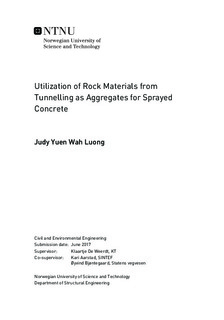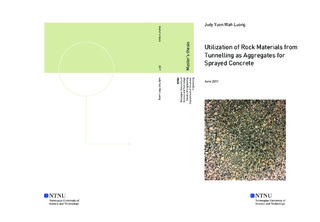| dc.description.abstract | The concrete industry in Norway, as well as other countries, is facing a great challenge nowadays. The enormous increase in demand for concrete production and the consequential increase in aggregate consumption have resulted in shortage of natural aggregate resources, especially in terms of suitable materials for concrete production. While the good natural aggregate resources in Norway are reducing in volume and number, great amounts of crushed masses are generated from tunnelling projects and transported over long distances to be deposited in sea and landfills. Crushed aggregates tend to have less beneficial properties with respect to concrete workability than natural aggregates, in the sense that these aggregates tend to have a higher fines content and a higher content of irregularly shaped particles. This explains why rock materials from tunnelling is not much exploited and why more research on this area is important.
In this study, the possibility of using crushed rock materials from tunnelling as aggregates in sprayed concrete has been evaluated. Crushed sand materials from two ongoing tunnelling projects, the Ulriken tunnel and the Follo Line tunnel, have been investigated and compared with a conventional natural sand. The evaluation has been based on their performance in fresh concrete. To better understand the relationship between aggregate properties and fresh concrete properties, the particle-matrix model has been implemented. In this material model, fresh concrete is considered as a two-phase system, consisting of a liquid part, the matrix phase, and a friction part, the particle phase.
The geometrical properties, that is, the grading, the fines content, the particle shape and the free mica content, of each sand material were characterized. Four concrete mixes, one with pure natural sand, two with combined natural/crushed sand and one with pure crushed sand, were studied. The properties of the particle phase and the matrix phase of each concrete mix were characterized by means of the void content test and the FlowCyl test, respectively. Finally, the rheological properties, the slump, the slump-flow, the yield shear stress and the plastic viscosity, of each concrete mix were characterized.
The results of this study have revealed that the geometrical properties of aggregates influence mainly the plastic viscosity of fresh concrete and to a lesser extent the yield stress, the slump and the slump-flow for a 200-mm-slump concrete. The results indicate that the plastic viscosity of a matrix dominated concrete mix, which is achieved with a low void content and a high matrix volume, is predominantly governed by the free mica content and the content of fine particles, whereas the plastic viscosity of a particle dominated concrete mix is mainly affected by the particle shape quality.
The results have demonstrated that up to 50 % of natural sand in sprayed concrete can be replaced with crushed rock materials from tunnelling, provided that the free mica content is not too high and the content of fines is kept at an acceptable level with respect to both stability and rheology of fresh concrete. Such replacement is possible even for crushed rock materials with a high content of irregularly shaped particles. This is because the effect of particle shape quality on fresh concrete properties is somewhat reduced for sprayed concrete, as this type of concrete typically is proportioned with a high matrix volume. However, the effect of particle shape quality increases with increasing content of irregularly shaped particles. Hence, replacing all natural sand with crushed rock materials from tunnelling will be unreasonable technically, economically and environmentally, unless dedicated efforts are made to improve the particle shape quality. | |

